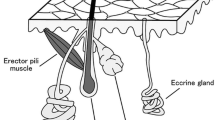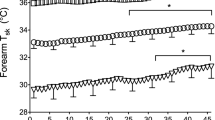Abstract
The aim of this study was to determine whether relatively long-term changes in skin friction induced by a pharmacological blockade of sweat excretion would alter the grip forces applied to objects of a variety of different surface textures and frictions. Five men and three women were asked to lift the vertically mounted armature of a linear motor between the thumb and index finger and to hold it against an opposing force for 2 s. A 1.0-kHz tone indicated to the subject that the manipulandum had been correctly positioned between the upper and lower position limits. The linear motor generated a 2.5-N force tangential to the skin surface simulating an object weighing approximately 250 g. Three different polyamide plastic surfaces (either smooth or etched with 1.0 mm high Braille beads evenly spaced at 2- or 3-mm intervals) contacted the fingers in these experiments. Subjects lifted and held in a precision grip one of the three surfaces for blocks of ten consecutive trials, but the order of presentation of the three different textures was varied to offset the effect of expectancy. On a second block of ten trials the subjects were requested to release the object slowly to measure the ratio of the grip force normal to the grasped surface to the tangential load force at the moment of slip. This ratio or its inverse provided the coefficient of friction or the slip ratio for a particular subject and surface condition. Twelve hours prior to a second recording session all subjects placed transdermal patches of 1.5 mg scopolamine behind each ear to reduce palmar sweating by blocking the muscarinic receptors of exocrine sweat glands. The subjects were re-tested following procedures that were identical to the first session. Scopolamine significantly reduced the friction of the skin on the smooth and 2-mm beaded surfaces, but the friction of the 3-mm beaded texture was unaffected. Scopolamine also caused subjects to increase both the peak and static grip forces for all the textures including the 3-mm beaded surface, suggesting that for two of the three surfaces they were responding to the increased slipperiness of the skin due to reduced sweat production.
Similar content being viewed by others
Author information
Authors and Affiliations
Additional information
Received: 28 October 1996 / Accepted: 8 January 1997
Rights and permissions
About this article
Cite this article
Smith, A., Cadoret, G. & St-Amour, D. Scopolamine increases prehensile force during object manipulation by reducing palmar sweating and decreasing skin friction. Exp Brain Res 114, 578–583 (1997). https://doi.org/10.1007/PL00005666
Issue Date:
DOI: https://doi.org/10.1007/PL00005666




